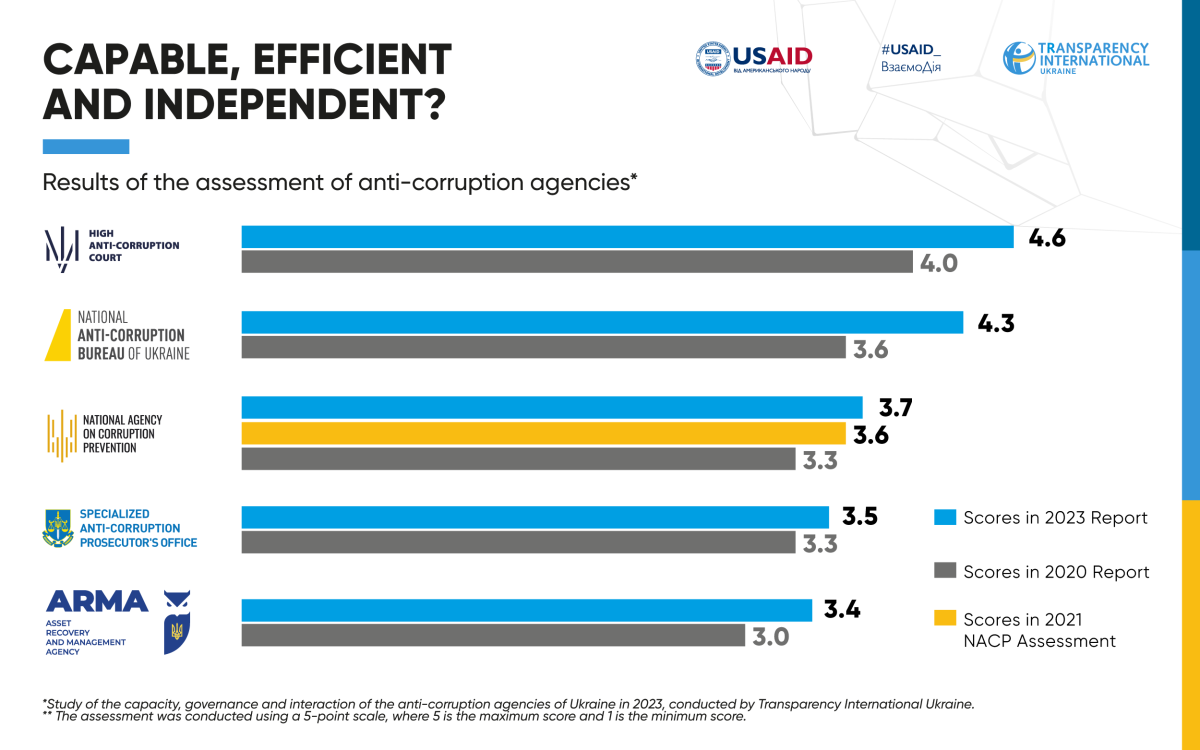Ukraine’s anti-corruption system has become stronger over the past 3 years, says a new study by Transparency International Ukraine. These results would have been unattainable without the help from international partners. Here’s why.
“Ukraine is the second most corrupt country in Europe!”
“Things with bribery do not change at all for a long time now!”
“The anti-corruption reform doesn’t work in Ukraine!”
In recent weeks, and even before that, these statements were repeated on some international platforms, on the media and from foreign officials. But how much truth is there to these statements, and how much of them is just the enemy trying to distort the perception of our country?
To be brief, these ideas are manipulative and inaccurate. But looking into it, we have a very specific response to prove why that’s just not the real situation.
On October 12, Transparency International Ukraine, an accredited chapter of the global movement Transparency International, published the second study of capacity, governance, and interaction of Ukraine’s anti-corruption agencies. It actually shows that the situation with anti-corruption is not as urgent as our enemies like pointing out.
This is especially evident when comparing this data with the first such study, which came out in the summer 2020, covering the period starting from 2015.
The new report covers the activities of five agencies: the National Anti-Corruption Bureau of Ukraine (NABU), the Specialized Anti-Corruption Prosecutor’s Office (SAPO), the High Anti-Corruption Court (HACC), the National Agency on Corruption Prevention (NACP), and the Asset Recovery and Management Agency (ARMA). We assessed their independence, transparency, accountability, integrity, resources, and interaction with each other and other stakeholders. Our analysis shows that every agency of the anti-corruption ecosystem has improved over the past three years. Their overall average score increased from 3.4 to 3.9 points on a scale from 1 to 5 over this period, which is quite telling. While the ARMA is trailing behind with 3.4 points, the HACC remains the leader of the rating with 4.6 points. And the NABU’s score increased the most — from 3.6 to 4.3 points. The improvement of the NACP and the SAPO is slower, with 3.7 and 3.5 points, respectively.
For example, during this time, the legal status of the NABU was clarified in order to comply with the principle of checks and balances between different branches of government. A case management system was introduced at the NACP. The work of the Supreme Council of Justice in its renewed composition has resumed, and so far no cases of its deliberate interference with the activities of HACC judges have been recorded, as it used to be before. Legislative restrictions on the remuneration of representatives of anti-corruption bodies, imposed with the outbreak of the COVID-19 pandemic, have also been lifted. Competitions were also held for the heads of the NABU, the ARMA and the SAPO.
This result was made possible by the real, effective triumvirate of civil society, the authorities, and international partners that established since 2014, following the Revolution of Dignity. In just under 10 years, this team managed to turn the previously existing ineffective anti-corruption system into brand-new infrastructure, which was only completed in 2019. Our research shows that anti-corruption agencies actually work, unlike the times when it was primarily the Security Service, the old-time police, and the prosecution responsible for the fight against corruption.
On the other hand, our research provides 85 recommendations to all these institutions, which can significantly improve the work of anti-corruption agencies in the near future, and 25 recommendations which we believe to be the top priority. Interestingly, this advice, just like the recommendations from the previous study, echoes the past comments and suggestions of international partners. And we saw similar ideas on improving the work of anti-corruption agencies in the recently published list of reform steps from the White House.
That is, once again civil society and international partners envision the same course for real improvement of the anti-corruption situation. Now the ball is in the government’s court.
As a country, we have no choice but to listen to the united voice of the expert and international community and make every possible effort to implement the proposed steps to strengthen the anti-corruption ecosystem. The past 9 years have shown that the power of anti-corruption agencies is the basis of the entire power of the state, and this is especially evident during the full-scale war.
On the other hand, the headlines in the media about corruption investigations can create a different impression altogether — like bribery in Ukraine is only flourishing against the backdrop of the war. But those headlines, in fact, actually show that anti-corruption agencies truly work.
This is also indicated by the Corruption Perceptions Index (СРІ), where Ukraine showed some of the best progress over the past ten years. Yes, our score may be far from the EU average yet. But this is not specifically about the level of corruption, but rather about its perception, indeed, which is also based on those very same headlines, which make us look like the outsiders among the European region.
Still, we must appreciate the work already done, as shown by alternative studies by civil society, including ours. And we must continue our work so that our citizens can have functional and effective anti-corruption agencies after the victory. And this, again, is impossible without continued international support.
This publication was made possible by the support of the American people through the United States Agency for International Development (USAID) within the ‘Support for Anti-Corruption Champion Institutions’ (SACCI) Project. The content of this publication is the sole responsibility of Transparency International Ukraine and does not necessarily reflect the views of USAID or the United States Government.







